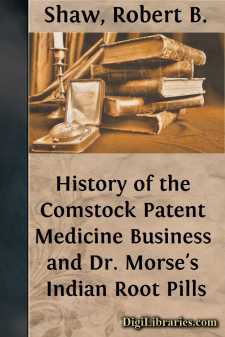Categories
- Antiques & Collectibles 13
- Architecture 36
- Art 48
- Bibles 22
- Biography & Autobiography 813
- Body, Mind & Spirit 142
- Business & Economics 28
- Children's Books 15
- Children's Fiction 12
- Computers 4
- Cooking 94
- Crafts & Hobbies 4
- Drama 346
- Education 46
- Family & Relationships 57
- Fiction 11828
- Games 19
- Gardening 17
- Health & Fitness 34
- History 1377
- House & Home 1
- Humor 147
- Juvenile Fiction 1873
- Juvenile Nonfiction 202
- Language Arts & Disciplines 88
- Law 16
- Literary Collections 686
- Literary Criticism 179
- Mathematics 13
- Medical 41
- Music 40
- Nature 179
- Non-Classifiable 1768
- Performing Arts 7
- Periodicals 1453
- Philosophy 64
- Photography 2
- Poetry 896
- Political Science 203
- Psychology 42
- Reference 154
- Religion 513
- Science 126
- Self-Help 84
- Social Science 81
- Sports & Recreation 34
- Study Aids 3
- Technology & Engineering 59
- Transportation 23
- Travel 463
- True Crime 29
History of the Comstock Patent Medicine Business and Dr. Morse's Indian Root Pills
by: Robert B. Shaw
Categories:
Description:
Excerpt
History of the Comstock Patent Medicine Business and of Dr. Morse's Indian Root Pills
For nearly a century a conspicuous feature of the small riverside village of Morristown, in northern New York State, was the W.H. Comstock factory, better known as the home of the celebrated Dr. Morse's Indian Root Pills. This business never grew to be more than a modest undertaking in modern industrial terms, and amid the congestion of any large city its few buildings straddling a branch railroad and its work force of several dozens at most would have been little noticed, but in its rural setting the enterprise occupied a prominent role in the economic life of the community for over ninety years. Aside from the omnipresent forest and dairy industries, it represented the only manufacturing activity for miles around and was easily the largest single employer in its village, as well as the chief recipient and shipper of freight at the adjacent railroad station. For some years, early in the present century, the company supplied a primitive electric service to the community, and the Comstock Hotel, until it was destroyed by fire, served as the principal village hostelry.
But the influence of this business was by no means strictly local. For decades thousands of boxes of pills and bottles of elixir, together with advertising circulars and almanacs in the millions, flowed out of this remote village to druggists in thousands of communities in the United States and Canada, in Latin America, and in the Orient. And Dr. Morse's Indian Root Pills and the other remedies must have been household names wherever people suffered aches and infirmities. Thus Morristown, notwithstanding its placid appearance, played an active role in commerce and industry throughout the colorful patent-medicine era.
Today, the Indian Root Pill factory stands abandoned and forlorn—its decline and demise brought on by an age of more precise medical diagnoses and the more stringent enforcement of various food and drug acts. After abandonment, the factory was ransacked by vandals; and records, documents, wrappers, advertising circulars, pills awaiting packaging, and other effects were thrown down from the shelves and scattered over the floors. This made it impossible to recover and examine the records systematically. The former proprietors of the business, however, had for some reason—perhaps sheer inertia—apparently preserved all of their records for over a century, storing them in the loft-like attic over the packaging building. Despite their careless treatment, enough records were recovered to reconstruct most of the history of the Comstock enterprise and to cast new light upon the patent-medicine industry of the United States during its heyday.
The Comstock business, of course, was far from unique. Hundreds of manufacturers of proprietary remedies flourished during the 1880s and 1890s the Druggists' Directory for 1895 lists approximately 1,500. The great majority of these factories were much smaller than Comstock; one suspects, in fact, that most of them were no more than backroom enterprises conducted by untrained, but ambitious, druggists who, with parttime help, mixed up some mysterious concoctions and contrived imaginative advertising schemes....


